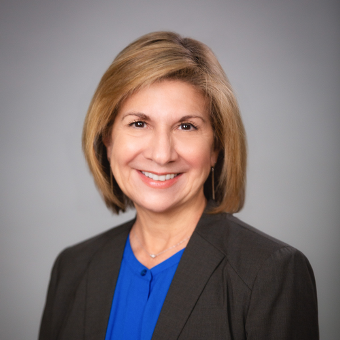
Elsewhere Operating Advisor Spotlight: Rita Selvaggi of ActivTrak

The best products often come from acutely understanding your customer’s pain points and working hard to alleviate them. ActivTrak has long been helping companies analyze and boost employee productivity, but that problem took on new meaning and importance this last year—almost overnight. Like their customers, ActivTrak had to adapt to COVID-induced shutdowns and remote teams, which gave the team fresh perspective on how to meet customers’ needs and strengthen their product.
For this month’s OA Spotlight, we talked to Rita Selvaggi—a software executive leader and Elsewhere Operating Advisor who joined ActivTrak as CEO in 2019—about experiencing this paradigm shift on the front lines. Elsewhere OAs partner with our portfolio companies as board members, executives and boots-on-the-ground advisors.
Read on for Rita’s perspective on the workplace of the future, defining success, her experience raising capital, and key turning points in her career.
2020 saw unprecedented changes in the workplace with remote work and team productivity. How do you expect all this to evolve in 2021? And what have you done as a CEO to manage through that?
Unprecedented now sounds almost like an understatement, doesn’t it? I think our experience as a company is similar to what we're hearing from many of our customers. We had to immediately go remote and manage all of the concerns and challenges associated with running a business effectively in that environment. Prior to that we had flexible work time, but we weren't all remote.
I fully expect—like every other business that we're talking to—that we have to make a decision about what work looks like beyond 2021. As a company, we decided this year that we're going to be remote first, which means we're only going to use office space intermittently for collaboration, or maybe a little bit of hotelling. A majority of our customers—about 77%—are talking about a similar hybrid work model going forward.
The so-called remote work movement is evolving to more of a flexible and distributed work model, often called hybrid work, which has implications for work operations long term. As a leader, I need to really understand how we evaluate productivity from an inside-the-office or outside-the-office perspective, and how we keep our teams engaged when we don’t have consistent in-office experiences to bring people together socially. All of these changes that our customers are going through we're actually living through too, and I think it gives us particularly great insight into how to use a product like ours to help us adapt and improve.
How will you define success for ActivTrak in the year ahead?
In 2020 we all realized how critical our employees are to digital businesses. Success for us in 2021, in large part, will be defined by our employee engagement, because great, happy employees make for great happy customers—which, of course, are the lifeblood of the business and future growth.
So fundamentally, one of the measures I'm looking at is, how's my team feeling? How are they growing? Are they getting the opportunities they're looking for? What's our retention around our team? Do my teams have the right resources, training and support to get their jobs done and how do we measure productivity going forward?
We are also really working to build a very strong base of happy customers who see the value in our productivity insights to help them set up effective work operations in the new hybrid work model. Building that base of customers—that is spreading the word about how powerful new productivity insights are to this future of work that is now upon us—is another big indicator of success for us. And then, of course, the metrics hopefully fall out of our priorities around our people and our customers—do we achieve our aggressive growth targets? Those are three big areas that are going to be indicators for us.
There's been a lot of dialogue in the last five years about getting a complete view of your customer. Now, you're hearing as much about getting a complete view of the employee experience because digital firms are making the connection that happy, productive employees bring happy, productive customers. I do think that's going to be a big watchword for us and other businesses in 2021.
What market segments do you think are poised for growth in 2021 and beyond?
Outside of our own space of workplace analytics and productivity for hybrid work models, I think 2020 was a wake-up call for so many of us with regard to improvements that can be made across many other industries. Take healthcare, for instance. People started doing telemedicine appointments and using remote tools to monitor their health and wellness—simply because they couldn't go into doctors’ offices. I would love to see more of that. And I believe that most people saw the success and the value of that experience. I hope for all of our sakes that telemedicine and other remote health monitoring tools are poised for growth, because I think there's a big opportunity for the improvement of healthcare delivery overall in that area, especially as a growing percentage of our population ages.
Similarly, we all learned quickly of the benefits and the convenience of ordering online and picking up your groceries and in ordering online for takeout from our favorite restaurants. It is an incredible time saver and makes you wonder why it didn’t catch on before a pandemic. I hope that a lot of those services stick around. Though that's not to say that I don't want to see us going back into restaurants! Because yes, I do miss that experience and look forward to the day when it is common again!
How should CEOs determine if they have good alignment with their investors? And how does this evolve over time?
I've been doing startups for over 15 years, and so I've had exposure to a lot of different types of investors at different levels. But this past year, as a CEO doing a Series B in the midst of a pandemic, it was especially important to think through what we wanted from another investor.
I learned through that process that we quickly got a sense of connection with the individuals who were asking questions that were not only insightful but helped us learn something about our business that we could then apply going forward. That's the kind of partner that stands out.
My advice to other CEOs is to listen hard for signals that are meaningful to you and your business and your team. That makes all the difference in the world. And after you do select your partner, communication is critical. I've had the good fortune to know [Elsewhere Partners’ founder] Chris Pacitti for a long time. And I don't hesitate to pick up the phone and talk to him about things. My advice to folks would be to do that early and often with an investor. Many of them have great resources to bring to bear, but those resources will go to the portfolio companies who are proactive about using them.
What advice would you give to leaders here building and scaling a company with limited resources? You only have so much capital to deploy in a given year, so how do you decide where to spend?
It's critical to build a thoughtful plan for the year. We start with the question that you asked at the beginning of this interview: What does success look like in the coming year? And then we work backwards from that—identifying the key milestones that we need to hit each quarter progressively to get to that goal.
At ActivTrak, we manage our business by OKRs (objectives and key results). I’ve used similar approaches in the past but the discipline and cross-team alignment around the OKR process has been very helpful to us in prioritizing our actions as a team. It’s also brought great transparency across the organization so that each team can see what other teams are working on and how all those activities come together for our goals as a company. We then build a financial plan to support the operating plan that is anchored in the OKRs.
What has been the most defining moment of your career so far?
The most defining moment for me was when I went back to business school some 20 years ago at UT here in Austin while I was running a sales organization at IBM. That was the moment when I decided that I not only wanted to work with smaller companies and startups—but I wanted to do that right away. That experience and subsequent decision changed the whole trajectory of my career and my life.
That was a big turning point and a valuable turning point for me. I was in business school classes with small company entrepreneurs and folks from other large companies like mine at the time. It was evident that I was drawn to the entrepreneurs in the class who were really applying the lessons of the business program to their world every week. It became clear to me: that's the real power of understanding business—the power of being able to apply business principles to decisions in real time, see them in action and see the results. From where I sat in a really big company, it was hard to feel the power of that impact as directly. Since I wanted to have more of an impact on a business, that experience at UT made me realize that I needed to take a leap of faith and go work at a startup. And I have never looked back.
This interview has been edited for length and clarity. You can learn more about Elsewhere OAs here and read our previous OA Spotlight blogs here and here.
